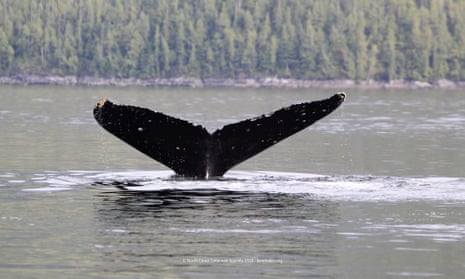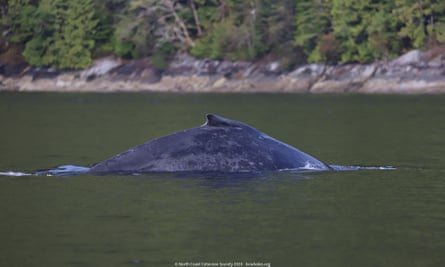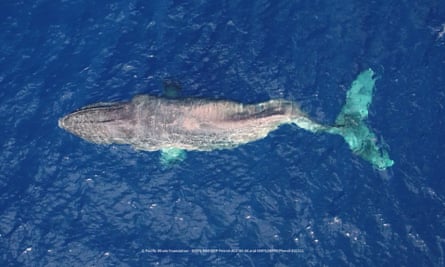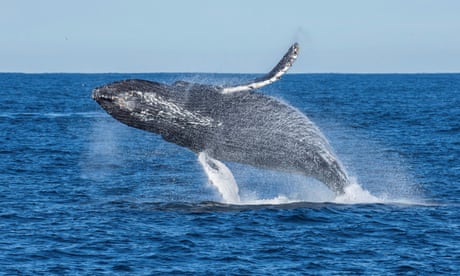Moon’s severe injury, likely the result of a boat strike, is stark reminder of growing dangers for whales along Canada’s west coast

‘Without the use of her tail, she was literally doing the breaststroke to make that migration,’ said Janie Wray, CEO and lead researcher for BC Whales. Photograph: BCWhales.org
The age of extinction
Leyland Cecco in Toronto

The age of extinction
Leyland Cecco in Toronto
Sun 11 Dec 2022
Over the course of nearly three months, navigating ocean swells and currents, vast expanses of flat water and immense pain, Moon the humpback whale completed a journey of 5,000km (3,100 miles) from the waters of British Columbia to Hawaii – all with a broken back.
Her crossing of the Pacific – and the likelihood that she will soon die – is a stark reminder of the growing dangers for whales along Canada’s west coast, as marine traffic clashes with the gentle marine giants.
“Without the use of her tail, she was literally doing the breaststroke to make that migration. It’s absolutely amazing,” said Janie Wray, CEO and lead researcher for BC Whales, a non-profit that studies cetaceans off the province’s west coast. “But also it just breaks your heart.”
Every September for the past decade, researchers at Fin Island research station in Gitga’at First Nations territory have spotted Moon when she appears in the coastal waters to gorge on nutrient-rich krill. Two years ago, researchers were overjoyed when she appeared with a calf.
But in September, a drone photographed a humpback whale with a grievous injury to its lower back: the entire lower portion of its trunk bent into an unnatural “S” shape – likely the result of a strike from a boat.

Over the course of nearly three months, navigating ocean swells and currents, vast expanses of flat water and immense pain, Moon the humpback whale completed a journey of 5,000km (3,100 miles) from the waters of British Columbia to Hawaii – all with a broken back.
Her crossing of the Pacific – and the likelihood that she will soon die – is a stark reminder of the growing dangers for whales along Canada’s west coast, as marine traffic clashes with the gentle marine giants.
“Without the use of her tail, she was literally doing the breaststroke to make that migration. It’s absolutely amazing,” said Janie Wray, CEO and lead researcher for BC Whales, a non-profit that studies cetaceans off the province’s west coast. “But also it just breaks your heart.”
Every September for the past decade, researchers at Fin Island research station in Gitga’at First Nations territory have spotted Moon when she appears in the coastal waters to gorge on nutrient-rich krill. Two years ago, researchers were overjoyed when she appeared with a calf.
But in September, a drone photographed a humpback whale with a grievous injury to its lower back: the entire lower portion of its trunk bent into an unnatural “S” shape – likely the result of a strike from a boat.

An aerial image of Moon. Photograph: BCWhales.org
“It was one of those ‘oh my God’ moments when we learned it was Moon. It’s not like she has scoliosis or something that just came out of the blue – she was struck by something pretty hard,” said Wray. “I’ve never seen anything like that in my lifetime as a researcher.”
Despite the severe injury, on 1 December, Moon was spotted off the coast of Maui, more than 4,800km from where the researchers first took note of her injury.
Humpback whales reach nearly 50ft long, weigh almost 90,000lb and are known for the immense journeys they undertake each year, travelling from frigid waters near Alaska all the way down to the lukewarm waters of Mexico and Hawaii, where they breed and give birth.
“This migration is part of their culture, their tradition. Moon was probably born in Hawaii. And she just goes back every single year, because that’s what her mother taught her to do,” said Wray. “It’s been passed down from mother to calf. That’s likely what drove her to travel all that way with her injury.”
“It was one of those ‘oh my God’ moments when we learned it was Moon. It’s not like she has scoliosis or something that just came out of the blue – she was struck by something pretty hard,” said Wray. “I’ve never seen anything like that in my lifetime as a researcher.”
Despite the severe injury, on 1 December, Moon was spotted off the coast of Maui, more than 4,800km from where the researchers first took note of her injury.
Humpback whales reach nearly 50ft long, weigh almost 90,000lb and are known for the immense journeys they undertake each year, travelling from frigid waters near Alaska all the way down to the lukewarm waters of Mexico and Hawaii, where they breed and give birth.
“This migration is part of their culture, their tradition. Moon was probably born in Hawaii. And she just goes back every single year, because that’s what her mother taught her to do,” said Wray. “It’s been passed down from mother to calf. That’s likely what drove her to travel all that way with her injury.”

‘She’s suffering and yet she’s still alive.’ Photograph: BCWhales.org
Images of Moon in Hawaiian waters, emaciated and covered in whale lice, highlight the extent to which she used up her fat stores to make the journey, and is left with no food source in the tropical waters.
But Wray said that there is little be done for the whale.
“She’s suffering and yet she’s still alive. We know she’s not coming back to see us again. She is going to pass soon and we all feel: the sooner, the better,” said Wray. Attempts to euthanize Moon would require a cocktail of toxic substances – and risk poisoning the marine life that would feed off her remains.
“If she was on land, we could intervene. But because she’s in the ocean, and because of her size, there is nothing that we can do. And that just breaks your heart even further into pieces.”
Wray hopes that Moon’s story can serve as a cautionary tale for the devastating effects collisions can have on whales. In recent months, humpbacks have washed ashore along the British Columbia coast from boat strikes. The deaths reflect both the success of a recovering population – and the reality that marine traffic hasn’t adjusted to a surge in whale numbers.

Mystery death of fifth humpback whale in Pacific north-west sparks alarm
“Even if you’re really a focused boat driver, you could accidentally hit a humpback whale because they will just come up in front of your boat. The most important thing to do is everybody needs to slow down, especially in areas where we know there are whales. It’s easy – just slow down. We have school zones. We need whale zones.”
But she recognized the whale’s plight and unlikely journey speaks to a deeper connection that humpback whales have to their habitat, their culture and tradition.
“Something deep within her drove her to just swim across the ocean, using just her pectoral fins,” said Wray. “Moon will never know how many people are thinking about her. And how many people I can guarantee you have been crying over her. I can’t even find the words to express the amount of honour – and respect – that I have for her.”
This article was amended on 11 December 2022. An earlier version said that Moon had travelled along Canada’s east coast instead of the west coast.
Images of Moon in Hawaiian waters, emaciated and covered in whale lice, highlight the extent to which she used up her fat stores to make the journey, and is left with no food source in the tropical waters.
But Wray said that there is little be done for the whale.
“She’s suffering and yet she’s still alive. We know she’s not coming back to see us again. She is going to pass soon and we all feel: the sooner, the better,” said Wray. Attempts to euthanize Moon would require a cocktail of toxic substances – and risk poisoning the marine life that would feed off her remains.
“If she was on land, we could intervene. But because she’s in the ocean, and because of her size, there is nothing that we can do. And that just breaks your heart even further into pieces.”
Wray hopes that Moon’s story can serve as a cautionary tale for the devastating effects collisions can have on whales. In recent months, humpbacks have washed ashore along the British Columbia coast from boat strikes. The deaths reflect both the success of a recovering population – and the reality that marine traffic hasn’t adjusted to a surge in whale numbers.

Mystery death of fifth humpback whale in Pacific north-west sparks alarm
“Even if you’re really a focused boat driver, you could accidentally hit a humpback whale because they will just come up in front of your boat. The most important thing to do is everybody needs to slow down, especially in areas where we know there are whales. It’s easy – just slow down. We have school zones. We need whale zones.”
But she recognized the whale’s plight and unlikely journey speaks to a deeper connection that humpback whales have to their habitat, their culture and tradition.
“Something deep within her drove her to just swim across the ocean, using just her pectoral fins,” said Wray. “Moon will never know how many people are thinking about her. And how many people I can guarantee you have been crying over her. I can’t even find the words to express the amount of honour – and respect – that I have for her.”
This article was amended on 11 December 2022. An earlier version said that Moon had travelled along Canada’s east coast instead of the west coast.
No comments:
Post a Comment